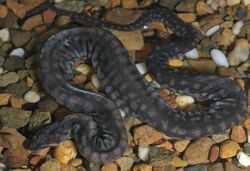Biology:Acrochordus arafurae
| Acrochordus arafurae | |
|---|---|

| |
| Scientific classification | |
| Domain: | Eukaryota |
| Kingdom: | Animalia |
| Phylum: | Chordata |
| Class: | Reptilia |
| Order: | Squamata |
| Suborder: | Serpentes |
| Family: | Acrochordidae |
| Genus: | Acrochordus |
| Species: | A. arafurae
|
| Binomial name | |
| Acrochordus arafurae McDowell, 1979
| |
| Synonyms | |
| |
Acrochordus arafurae, known by the common names Arafura file snake, elephant trunk snake, and wrinkle file snake, is an aquatic snake species found in northern Australia and New Guinea. No subspecies are currently recognized.[3]
This snake was first described by Samuel Booker McDowell in 1979[4][5]
Description
Adults grown to 8.25 ft (2.5 m) in length.[6] They have very loose skin and are known to prey on large fish, such as eel-tailed catfish. Females are usually larger than males and they have been known to give birth to up to 17 young. The skin is used to make drums in New Guinea.
In Aboriginal language and culture
Arafura file snakes are often hunted by indigenous peoples of Northern Australia.
In the Kunwinjku language of West Arnhem Land, the snakes are known as kedjebe (or bekka in Eastern dialects),[7] while in the Yolŋu language of East Arnhem Land they are called djaykuŋ,[8] among other names.
References
- ↑ Sanders, K.; Guinea, M.; Cogger, H. (2010). "Acrochordus arafurae". The IUCN Red List of Threatened Species (IUCN) 2010: e.T176764A7299709. doi:10.2305/IUCN.UK.2010-4.RLTS.T176764A7299709.en. http://www.iucnredlist.org/details/176764/0. Retrieved 10 January 2018.
- ↑ McDiarmid RW, Campbell JA, Touré T. 1999. Snake Species of the World: A Taxonomic and Geographic Reference, vol. 1. Herpetologists' League. 511 pp. ISBN:1-893777-00-6 (series). ISBN:1-893777-01-4 (volume).
- ↑ "Acrochordus arafurae". Integrated Taxonomic Information System. https://www.itis.gov/servlet/SingleRpt/SingleRpt?search_topic=TSN&search_value=634831. Retrieved 16 August 2007.
- ↑ "Australian Faunal Directory: Acrochordus arafurae" (in en). https://biodiversity.org.au/afd/taxa/Acrochordus_arafurae.
- ↑ , Wikidata Q56037668
- ↑ Burnie D, Wilson DE. 2001. Animal. Dorling Kindersley. 624 pp. ISBN:0-7894-7764-5.
- ↑ Garde, Murray. "kedjebe". Bininj Kunwok Regional Language Centre. https://www.njamed.com/#kedjebe.
- ↑ "djaykuŋ". Charles Darwin University. http://yolngudictionary.cdu.edu.au/word_details.php?id=2660.
External links
- Acrochordus.com
- Species Acrochordus arafurae at The Reptile Database. Accessed 16 August 2007.
- Arafura Filesnakes at Life is Short but Snakes are Long
Wikidata ☰ Q1887786 entry
ru:Яванская бородавчатая змея
 |


